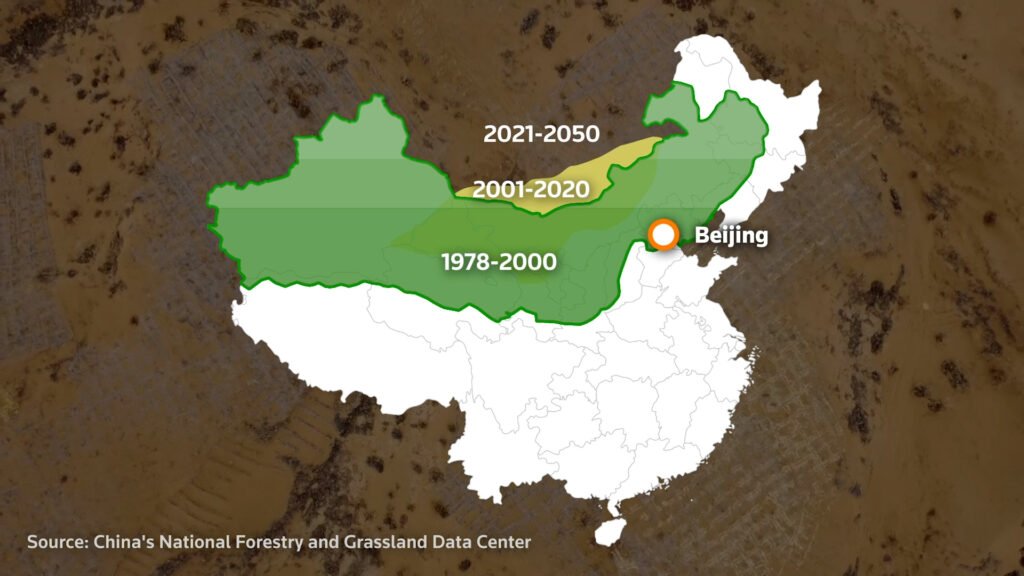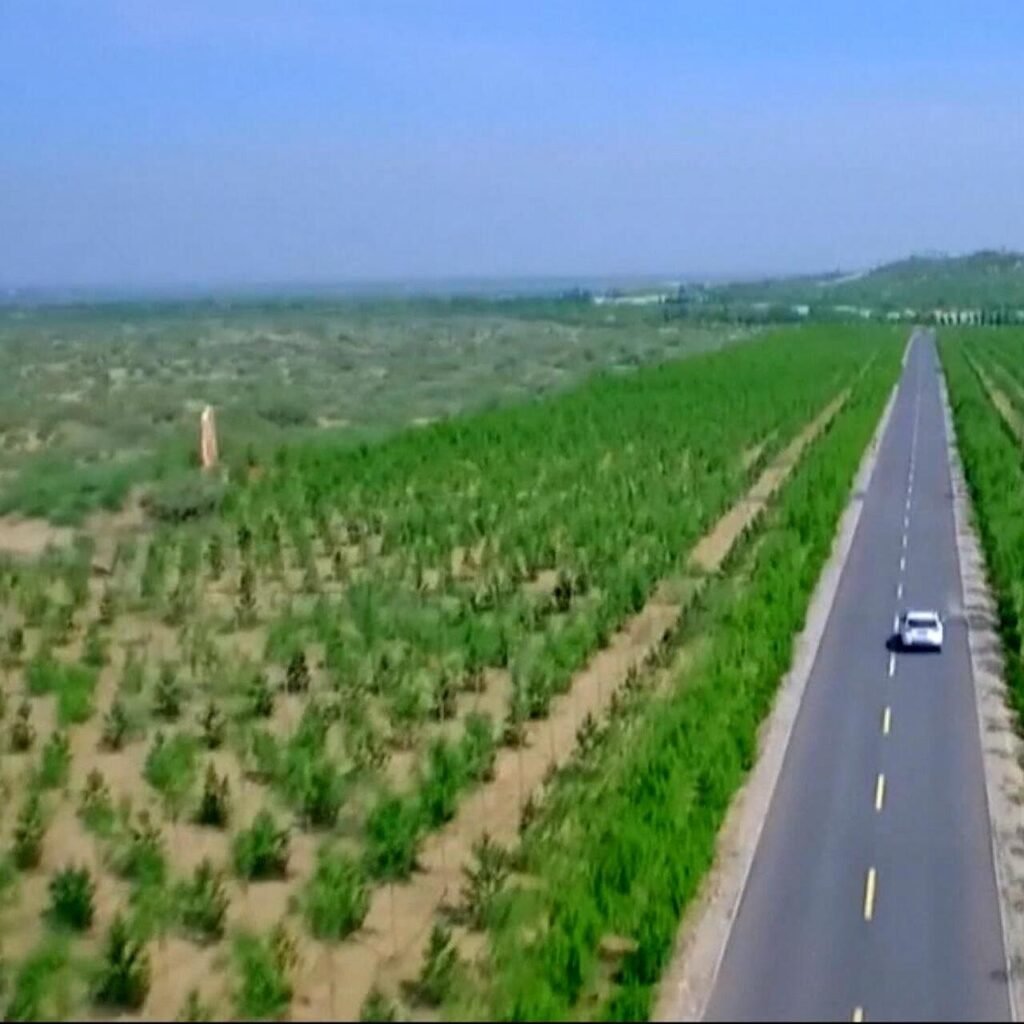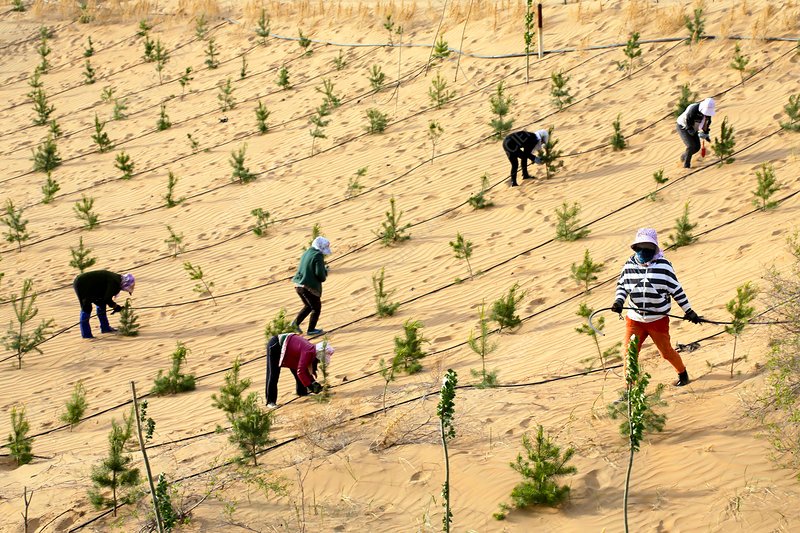China’s Green Wall, also known as the Three-North Shelter Forest Program, is one of the world’s most ambitious ecological projects. Envisioned as a solution to combat desertification and mitigate the impacts of climate change, the initiative aims to create a vast forest belt spanning approximately 4,500 kilometers across northern China. This essay explores the multifaceted aspects of China’s Green Wall, examining its advantages, disadvantages, and unintended consequences
The “Green Wall of China” usually refers to a massive afforestation project to combat desertification in northern China. This initiative involves planting trees and vegetation to create a barrier against the advancing desert, primarily the Gobi Desert, which threatens to encroach further into fertile land and inhabited areas.
The project has been ongoing for several decades, with efforts to plant trees such as the fast-growing and hardy species like the Chinese pine and the drought-resistant shrub, the Saxaul. The intention is to stabilize soil, prevent erosion, and restore ecosystems in areas affected by desertification.
The Green Wall of China project is significant not only for its environmental impact but also for its socio-economic implications, as it aims to improve living conditions for people in affected regions by preserving arable land and providing opportunities for sustainable development. However, there have been criticisms and challenges associated with the project, including issues related to the choice of tree species, the effectiveness of implementation, and the long-term sustainability of the initiative.

Advantages of China’s Green Wall
- Ecosystem Restoration: The Green Wall facilitates the restoration of degraded ecosystems by planting trees and restoring vegetation cover, thereby enhancing biodiversity and ecosystem services.
- Desertification Mitigation: One of the primary objectives of the Green Wall is to combat desertification by stabilizing dunes, reducing soil erosion, and preventing the expansion of arid regions.
- Carbon Sequestration: Afforestation and reforestation activities associated with the Green Wall contribute to carbon sequestration, helping to mitigate climate change by removing carbon dioxide from the atmosphere.
- Job Creation and Economic Development: Implementing the Green Wall project has created employment opportunities, particularly in rural areas, through tree planting, land rehabilitation, and associated industries, fostering economic development.
- Water Resource Management: Forest cover established under the Green Wall can help regulate water cycles, improve soil moisture retention, and enhance water infiltration, thus contributing to sustainable water resource management.

Disadvantages of China’s Green Wall
- Ecological Imbalance: Introducing large-scale monoculture plantations for the Green Wall may lead to ecological imbalances, disrupting native ecosystems, and reducing biodiversity.
- Water Demand and Competition: Afforestation activities often require substantial water resources, leading to increased competition for water, especially in water-stressed regions, which may exacerbate existing water scarcity issues.
- Soil Degradation: Improper land management practices associated with afforestation efforts can lead to soil degradation, including soil compaction, nutrient depletion, and loss of soil fertility, which may have long-term negative impacts on agricultural productivity.
- Social Displacement: In some cases, the implementation of the Green Wall project has resulted in the displacement of local communities, particularly indigenous populations, leading to social unrest, loss of livelihoods, and cultural erosion.
- Invasive Species Introduction: Introducing non-native tree species for afforestation purposes may inadvertently facilitate the spread of invasive species, threatening native biodiversity and ecosystem stability.

Side Effects of China’s Green Wall
- Climate Feedback: While the Green Wall aims to mitigate climate change by sequestering carbon dioxide, the effectiveness of afforestation in reducing atmospheric carbon levels may be limited by factors such as land-use change, soil carbon dynamics, and potential climate feedback.
- Altered Microclimate: Large-scale afforestation can alter local microclimates by modifying temperature, humidity, and wind patterns, which may have both beneficial and adverse effects on regional weather patterns and agricultural productivity.
- Policy and Governance Challenges: The implementation of the Green Wall faces various policy and governance challenges, including inadequate enforcement of environmental regulations, lack of community participation, and corruption, which can undermine the success and sustainability of the project.
- Long-Term Sustainability: Ensuring the long-term sustainability of the Green Wall requires ongoing monitoring, adaptive management, and investment in ecological restoration, which may pose significant financial and logistical challenges over time.
China’s Green Wall represents a bold attempt to address pressing environmental challenges such as desertification, climate change, and biodiversity loss. While the initiative offers several advantages, including ecosystem restoration, carbon sequestration, and economic development, it also poses significant disadvantages and unintended consequences, such as ecological imbalance, social displacement, and policy challenges. To maximize the benefits of the Green Wall and minimize its adverse impacts, policymakers must adopt a holistic and integrated approach that prioritizes ecological integrity, social equity, and long-term sustainability.
